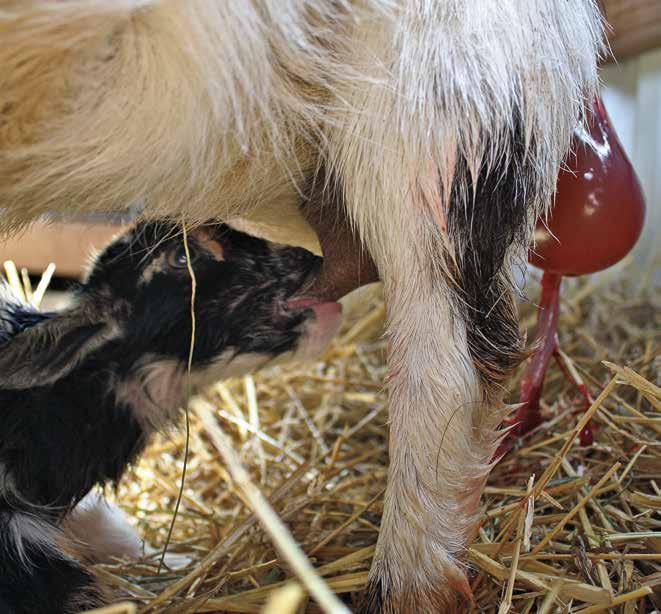
10 minute read
Sherri’s triplets (for the sixth time
The head is out, and once again Sherri is pushing so fast that I’m not able to break the sac as quickly as I’d like to.
The kid’s body is out, and I still haven’t been able to break the amniotic sac. because it clearly was not real pushing. Goats do not push for two days before giving birth to perfectly healthy kids. A goat is not really pushing until it is craning its neck, curling its tail over the back, and either holding its breath or letting out some kind of noise. I often think of Sherri’s first birth on our farm when a new goat person tells me that their goat has been pushing for hours or that it has been in labor for days. I always ask them to explain exactly what they mean by that. Pushing is exhausting, and most does can’t do it for more than a couple of hours. Then they just lie down and give up, and contractions get farther and farther apart until they stop entirely, which you will see in some of the later stories.



THU MAY 13 2010
Sherri is 7 years old, and she came to live here as a yearling. Her breeder said not to worry about kidding difficulties. As a yearling, Sherri kidded in the pasture with triplets while her owner was preparing a kidding pen for her. Well, “Don’t worry” is subjective. It kind of depends on what you want to worry about. I do not have to worry that she’ll have any sort of dystocia. Her pelvis is big enough for a Mack truck to go through at top speed. However, there are other things to worry about.
As a 2-year-old here, we thought she was in labor for two days, and we kept her
in the barn. Then I finally decided that we had no clue what was happening, so we let her go out into the pasture. About fifteen minutes later, my son reported that there were three kids in the pasture with her, and one wasn’t looking good. When I got there, I thought it was dead, but my daughter insisted it was alive. We took the tiny doeling into the house and put her in a sink of warm water because she was ice cold and clearly suffering from hypothermia. She finally snapped back into the world, and she grew up to be a fine doeling. I, however, am still traumatized by the experience five years later. Sherri gives birth too efficiently — so easily that she doesn’t have time to clean off the three or four kids that she always births. Every year, Sherri makes me think she’s going to kid any minute now for about two days. This year (as in years past), I thought that I was older, smarter, wiser, and I’d know. Right? Wrong! For two days, I kept thinking that she was going to kid soon. On Saturday, although she didn’t act like she was in labor, her belly was hollowed out between her ribs and hips and her ligaments were so soft that they could be gone any minute. Her udder didn’t look like it was ready to explode, but there’s a little wiggle room in that particular criterion. On Sunday, we had tickets to a Broadway play in Chicago, and I tried to explain the situation to Sherri, but she


I finally am able to dig my fingernails into the sac as another bag of amniotic fluid is coming out with the kid.
The toughness of the amniotic sac can vary from birth to birth. Most of them are not difficult to break, although it’s easier to do if you are not wearing gloves. Being able to use your fingernails definitely makes it easier.

looked at me like I was nuts. “Could you please have your kids now? Within the next hour?” Nope. Katherine stayed home on kid watch. Even though Sherri wasn’t showing signs of labor, she can go from zero to three kids in about twenty seconds. So Katherine waited . . . and watched . . . and waited . . . and watched . . . and you get the idea. Sherri did not kid Sunday while we were at the play.
Monday morning, the ligaments were gone, so I knew it would be soon. But the thing about Sherri is that she is the most stoic goat in the world. She makes NO sound until the kid is actually being born — as in, the kid is shooting out at that moment.
Logic and science not being on my side, I decided to trigger Murphy’s Law to get Sherri to go into labor. I told Katherine that I was going to make some bran muffins. I figured that I’d be in the

I use my fingers like a squeegee to clean off the kid’s nose so he can breathe.


middle of making muffins when Sherri would start to give birth, because that would be really inconvenient. I peeled and diced an apple, mixed up the muffins, put the muffin batter in the oven, and still no sound from the kidding barn. Fine! I’ll have lunch! I heated up some leftover tamale pie that we’d had for dinner the night before, and I sat down. I took a bite . . . and “Maaaaaaaa!” came over the baby monitor. Katherine looked at me and laughed as I said with a mouthful of food, “ONE bite!”
“I’ll check on her.” Katherine said. A moment later, as I was in the middle of my second bite, I heard her scream over the monitor, “Baby!”
With my mouth full of tamale pie, I pulled off my reading glasses and dropped them on the table, dashed to the front door,



Then I use a towel to
get even more mucus off his nose. Yes, Sherri gave birth standing up. It’s not terribly common, but sometimes goats do it. When I saw the thick umbilical cord to the left of the membranes, I started to think that she might be done and there would be no more kids.

One of Sherri’s kids finds his first meal within minutes of being born! Unfortunately, the camera snapped before he really had a good latch on the teat. In this photo, he has only about half of it in his mouth, which would be uncomfortable for Sherri if he continued nursing like that. Luckily, most kids realize quickly that they need to have the entire teat in the mouth while nursing. The tongue should cover the lower teeth. You’ll notice that he is not standing up but rather is on his knees to be able to access the teat. Only the tiniest of kids with the tallest of moms would stand up to nurse. pulled on my shoes, and ran across the yard towards the barn. (Note: Chewing and running are really not compatible activities. Do NOT try this at home!) I arrived at the kidding barn as I was swallowing my tamale pie, trying not to inhale anything and choke.
Katherine was laughing about Sherri’s impeccable timing, and I suggested that she retrieve her brand new camera from the house so that we could get pictures. (She’s been saving her money for months to buy a fancy DSLR camera.) She took my advice and then proceeded to take more than one hundred photographs of the birth.
Sherri took an unusually long time between kids this year. For her, that means we were able to get each one dried off before the


next one was born. It was really fun compared to most years, when she is shooting them out faster than we can dry them or even check the gender of each kid.
The first two kids were does, and then she had a buck, which was pretty cool because that is exactly what was reserved from her. So, yes, that means that all these sweet little darlings are going to another farm to live. But that’s okay, because this was a repeat breeding of the one that produced Jo, whom I dearly love. She fed triplets last year as a first freshener, so she’s an awesome little milker.
Back at the ranch, uh, house, the timer on the oven was going off. Luckily, Jonathan (my son) was still inside, and he knew it was for the muffins, so he pulled them out of the oven. No one, however, knew that I had put my big tomato plants out on the deck for their hardening off time. When I went back inside an hour later and saw them out there, they were only a little wilted, and I pulled them inside immediately.

Sherri is one of those goats who gave birth here nine times. Her second stage of labor was always faster than average. If we had not understood that every birth is different, there might have been times we would have been worried about her. In fact, when she was 10 years old, she was in labor when I got a call that some of our llamas were at a farm about half a mile away. We had an intern at the time, and I told her that I was going to go get the llamas because I wasn’t worried about Sherri. The intern had already attended several births, so she knew the basics of drying off kids when they were born, and that’s all that likely would be needed with Sherri. I told her that if by chance the kid wound up being in some weird position, it wouldn’t be an emergency situation and that she could just call me and I’d come back. After about half an hour I got a call on my cell. The intern was worried that something was wrong because Sherri was pushing but the kid wasn’t coming out. I told her not to worry, reiterating the goat’s excellent birthing history and that we had plenty of time. It was

obvious that she was very worried in spite of my attempt to reassure her, so I told her I was on my way back and that she should not do anything to intervene in the meantime. When I arrived, I found the intern toweling off a newborn kid. We named the doeling Sophie Kinsella because all of Sherri’s kids were named after authors. Sophie still lives with us today and has the same excellent birthing ability as her mom.
Seeing the birthing ease that Sherri and all of her daughters, granddaughters, and great-granddaughters display is one of the reasons I am so committed to not interfering in every birth. I want to have goats that have the natural ability to give birth easily. I don’t feel like I am doing the breed any favors by routinely doing a vaginal check on every doe, re arranging kids that are still high in the uterus, and then pulling kids. How do you know if a goat gives birth with ease if you never let her try to do it on her own? If you’ve read this far, you know that I want to be at every birth just in case, but if a doe repeatedly needs help birthing her kids, I won’t continue to breed her because I don’t want to perpetuate those genetics.





